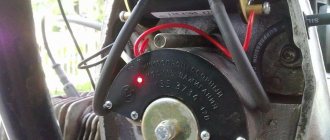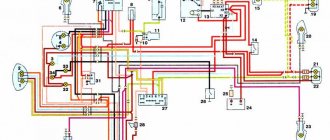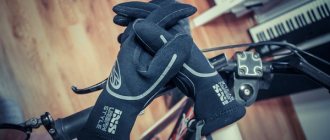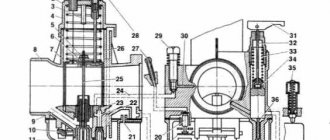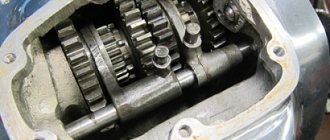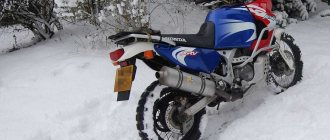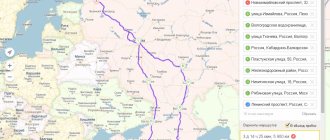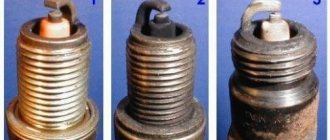Driving in particularly difficult areas
The air pressure in the tires should be reduced to the required values, which correspond to better maneuverability on a particular road section. The transfer case differential is blocked, since towing the drive wheel pair in conditions of loss of movement or slipping with a locked differential causes intense wear on the differential of the box. Tires also wear out.
You need to move the truck, repeat gear shifting to move forward and backward if it is difficult to engage or disengage the differential lock, or change speed modes. It is worth locking the cross-axle differential of the rear axle if you are driving through a difficult section of the road where there is a risk of slipping.
Locking should be done when the vehicle is completely stopped (the wheels are stationary). Blocking of the small forest differential in driving conditions is allowed at a speed of 30 km/h, no more (provided there is no wheel slip).
Make sure that the locking mechanism is fully engaged after the locking valve has been turned on. A lighted warning light will help you find out for sure. If the locking mechanism is not fully engaged, this may cause gearbox failure.
As soon as the difficult section of the road is left behind, you should turn the rear axle differential lock valve to the “Off” position. The indicator should go off, which confirms the off position and the clutch is disconnected.
Moving with a trailer and semi-trailer
To ensure the functionality of the towing device, use a coupling loop with an internal diameter of 90 mm, its cross-sectional size is 42 mmg, the parameters of the towing hook are: throat diameter 48 mm, width in the throat area 69 mm. Possible largest dimensions: loop section 38 mm, hook width 66 mm, hook mouth 52 mm.
During the maneuver, avoid the possibility of folding the trailer all the way into the end of the frame side member or other elements of the trailer tongue machine. This could cause the trailer eye to become jammed in the towbar opening, causing the towbar to break.
When passing particularly difficult sections, disconnect the trailer, and after passing the section, winch it to the car. Remember that there should be three or four turns on the drum. Pull the trailer at medium engine speed. Do not tow a trailer with a winch cable.
When passing difficult sections of the road with a Ural: 43203-10 or 43203-31 with a trailer (or during a maneuver), do not allow the spare wheel and its holder to come into contact with the trailer.
Remember that in difficult road conditions, the road train moves well when the tractor and semi-trailer in the horizontal plane do not have a folding angle or this angle is very small. If the folding angle increases, then a lateral force begins to act. It tends to cause the tractor to slide sideways or overturn it.
When driving with the auxiliary brake activated on a slippery surface with a low coefficient of adhesion and the absence of a solenoid valve for the brake system on trailers, the trailer may fold and skid.
Source
Only forward, not a step back: test drive Ural-4320
Eternal soldier of Russia
And more precisely, also the Soviet Union. And it all started in 1961, when the Ural Automobile Plant, located in Miass, pleased the army, but even more so the oil workers and refiners with its Ural-375D car. This vehicle very quickly received the telling name “Glutton”: the truck could gobble up 50-70 liters of fuel per hundred kilometers. Moreover, not diesel fuel: its eight-cylinder, seven-liter engine was gasoline. In general, the military respects diesel more, but there is also a relatively small resource, gasoline, and an enormous appetite... It was necessary to do something with this car, and first of all, change the power unit. This is how the diesel Ural-5320 appeared.
This was in 1975, but until 1992 the Ural-375D was never taken out of production, especially since it still had some advantage over the new car: the cross-country ability of the previous car was slightly higher. Mainly due to the fact that its gasoline engine was not equipped with a fuel pump speed controller, which was installed on the diesel Ural. The Ural-375D could drive at minimum speeds off-road, and its successor, under the same conditions, tried to independently increase the fuel supply and turn the wheel in the mud - even though it was a diesel engine! Nevertheless, the Ural-4320 eventually replaced its gasoline predecessor in the army.
However, the “conscription commission” did not recognize the recruit fit for service so quickly. The first attempts to recruit diesel into the ranks of the army did not have much success: the Ural-640 engine, which they tried to make friends with the Ural-375, turned out to be unreliable, and it was decided to build a completely different Ural, for which the Yaroslavl Motor Plant was ordered to design a new diesel power plant unit. A new gearbox was also required, so since 1969, designers sat down at the drawing boards with the goal of not just modernizing an existing car, but making an almost new car.
Although the Ural-4320 turned out to be similar in appearance to the Ural-375D, it is quite structurally different from it. Since 1977, the power unit of the Ural-4320 was the KamAZ-740 engine, but after a fire at the plant in 1993, the Ural returned to YaMZ engines, and now there are two of them: the six-cylinder YaMZ-236NE2 and the eight-cylinder YaMZ-238. The car we are going to look at today is equipped with an eight-cylinder V-twin engine. Its power is 240 hp, volume is 10.85 liters. In general, there is something to see.
Find five differences
For most normal people, the Ural is a large vehicle with six wheels, but not a ZIL or a KrAZ (if anyone still remembers the latter). But based on some details of the Urals, you can approximately determine the age of the car and the type of engine under the hood. Such knowledge will probably not bring practical benefit, but if necessary, you can show off beautifully in front of your friends. That's why we tell you.
If the “face” of the Urals is not too elongated, then this is a car produced before 2000, and under the hood it has a six-cylinder diesel engine YaMZ-236NE2 (after 2000, all Urals were produced with a long hood). If there is no air filter on the right side of the wing, then the engine is different, namely KamAZ-740, and the car is also more than 15 years old. Well, the Ural with a new cabin, produced after 2009, can be distinguished immediately: it no longer resembles a normal Ural, it does not evoke reverent delight, as well as horror and respect. Our car is another matter: the Ural in all its masculine glory. Let's take a closer look at it.
The long nose is not only a consequence of the fact that somewhere it was necessary to fit an impressively sized engine. The fact is that immediately behind the grille there is a pair of oil radiators. Under the bumper there is a bracket, by stepping on which you can climb onto the bumper in order to open the hood. It’s interesting to see what the V8 of the Urals looks like.
Well, as expected, the generator is located at the very top, the air intake is located above the wing. You can safely climb into a ford up to one meter deep, you just need to close the radiator blinds. But you shouldn’t go to the maximum depth that the Urals can overcome (up to 1.7 m “taking into account the waves” - that’s what the instructions say) without some preparations. However, it doesn’t take too long to disconnect the fan clutch, make sure the batteries are sealed (there are two of them) and close the exhaust pipe with a special ford valve.
There is a device under the hood that should ensure the engine starts in cold weather. Access to the “control panel” is quite convenient. Let's see what we can click here.
We turn on the pump with one toggle switch, then the electric heating of the coolant. The colder it is outside, the longer the heating turn on time. Then we start the heater boiler and wait until the engine warms up. After this, the system can be turned off and the engine can be started in the usual way. In reality, this is a little more difficult than it seems, but you can do the job. As a result, the Ural can be started even in severe frost, minus 30, however, all these operations will have to be carried out in this same frost. We will tell you below how to start the engine easier.
While getting onto the bumper is quite easy, getting off is a little more difficult. It’s easier to jump off the bumper (from it to the ground - a little less than a meter) than to find this bracket, along which the designers suggested climbing and descending. You can’t see it from above, and you won’t be able to feel it with your foot right away.
iffGeniy1311 › Blog › Training for category “C”
I went to study for category “C” at DOSAFF (where I studied for “B”, they didn’t teach trucks, alas), and almost immediately signed up to drive. They train on the URAL-4320, which is no less than 30 years old. Due to the lack of a site (autodrome) in Ruzaevka and my driving skills, the instructor conducted the first driving on a country road, leaving the city towards “Suzgar”. The route I covered on the first day will be shown in the photo:
Of course, after the 7th round, driving a Ural is something different, but interesting. Previously, I drove a GAZ-53, and drove a KAMAZ, and drove tractors (while I worked as an assistant combine operator while a school student) and, as a result of the same work, drove a combine harvester (I had an Acros 530). But I drove all this along a cross-country road, in a field, where there was no fear of encounters with other cars. In the Urals, we had to quickly adapt to the dimensions of the car. So everything is fine, but controlling the starboard side is problematic due to the shaking (even dangling) stand with mirrors. Having passed the suburban part of the route, we began to enter Khimmash. I expected the instructor to get behind the wheel himself, but in response to my question “will you get behind the wheel here?”, I suddenly heard “no, go ahead.” In general, there was no problem with this, but there was a small snag - while driving along the highway, I almost didn’t use the brakes and my leg “didn’t remember” the moment they were activated. Everything would be fine, but either because of old age, or because of the very design of the brake system, the braking on this crane machine is inert or something - the brakes engage with a very large delay, indeed with a very large delay. Plus, the pedals are hellishly tight))) This was somewhat annoying when driving around the city, where there are a lot of cars, as well as pedestrian crossings and people who DO NOT walk on them, but climb anywhere) The car is such that it is more than 55- It was impossible to drive it at 60 km/h even on the highway; in the city, of course, for safety reasons, I drove more slowly. I would like to apologize to everyone I detained on January 5 from 10:00 to 10:30 (approximately) while I was moving from Khimmash towards Ruzaevka along the street. Lunacharskogo to st. Mayakovsky 102, as well as yesterday (January 11th) from 17:10 to 17:30 on the same route
. There’s nothing to be done, this car simply doesn’t go uphill at more than 30-35 km/h, and I was careful myself, since I haven’t really driven this car yet...
No license plate
How to ride a motorcycle without license plates, and is it possible to drive a bike without a state license plate? The answer to the question is obvious - this directly contradicts the current traffic rules. Driving a vehicle without a license plate is only permitted if it has recently been lost. Undoubtedly, such motorcycles will definitely attract the attention of traffic police officers.
If the motorcycle is operated far from the city or in an area where traffic control is rare or does not occur at all, riding without license plates is quite possible.
A smart driver who is well acquainted with traffic rules, has legal knowledge, and even better, if directly related to this, will not have any difficulty convincing the law enforcement officer of the authenticity of all documents and the legality of driving.
In turn, a competent inspector has every right to check the information provided. Therefore, driving without license plates is quite dangerous. Punishment for such tricks can be completely different: from a fine to confiscation of a vehicle in especially aggravating circumstances.
